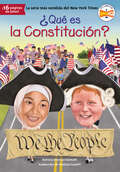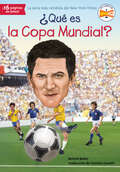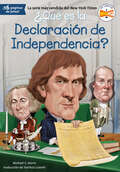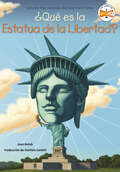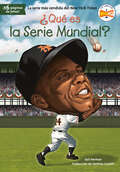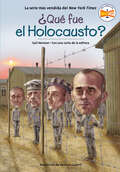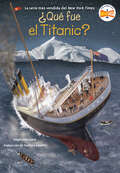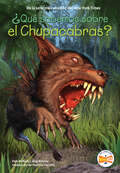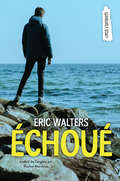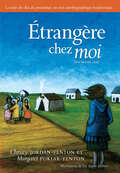- Table View
- List View
¿Qué es la Constitución? (¿Qué fue?)
by Patricia Brennan Demuth Who HQNosotros, el pueblo de Who HQ, traemos a los lectores la historia completa (argumentos y todo) de cómo surgió la Constitución de los Estados Unidos. We the people at Who HQ bring readers the full story--arguments and all--of how the United States Constitution came into being in this Spanish entry in the WHO HQ series.Firmada el 17 de septiembre de 1787, cuatro años después de la Guerra de la Independencia, la Constitución estableció la ley suprema de los Estados Unidos de América. Hoy es fácil que demos por sentado este proyecto de gobierno. Pero los legisladores (cincuenta y cinco hombres de casi todos los 13 estados originales), discutieron ferozmente durante muchos meses sobre lo que acabó siendo solo un documento de cuatro páginas. Esta es una fascinante mirada entre bastidores a las cuestiones más disputadas (las de los estados del Norte y del Sur; los estados grandes y los pequeños) y a los actores clave, como James Madison, Alexander Hamilton y George Washington, que sufrieron innumerables revisiones para hacer realidad la Constitución. Signed on September 17, 1787--four years after the American War for Independence--the Constitution laid out the supreme law of the United States of America. Today it's easy for us to take this blueprint of our government for granted. But the Framers--fifty-five men from almost all of the original 13 states--argued fiercely for many months over what ended up being only a four-page document. Here is a fascinating behind-the-scenes look at the hotly fought issues--those between Northern and Southern States; big states and little ones--and the key players such as James Madison, Alexander Hamilton, and George Washington who suffered through countless revisions to make the Constitution happen.
¿Qué es la Copa Mundial? (¿Qué fue?)
by Bonnie Bader Who HQGOOOLLLLLASSSOOOOO! Prepárate para asistir en primera fila al evento deportivo más visto del planeta: la Copa del Mundo GOOOLLLLLASSSOOOOO! Discover the magic behind the world's most watched sporting event, the World Cup, in this Spanish entry in the WHO HQ series!Cada cuatro años, treinta y dos de los mejores equipos de fútbol masculino de todo el mundo compiten por el título de campeón de la Copa Mundial de la FIFA. Más de mil millones de personas sintonizaron sus TV en todo el mundo para ver el partido final de la competición de 2014, lo que convierte a la Copa del Mundo en el acontecimiento deportivo más visto del planeta, ¡incluso por encima de los Juegos Olímpicos de verano! Este libro repasa lo que ha cambiado desde el primer torneo en 1930 y lo que le espera al deporte más popular del mundo. Every four years, thirty-two of the best men's soccer teams from across the globe compete for the title of FIFA World Cup winner. Over one billion people tuned in worldwide to watch the final game of the 2014 competition, making the World Cup the most widely viewed sporting event in the world, exceeding even the Summer Olympics! This book takes a look back at what has changed since the first tournament in 1930 and what lies ahead for the most popular sport in the world.
¿Qué es la Declaración de Independencia? (¿Qué fue?)
by Michael C. Harris Who HQStep back in time to the birth of the United States and meet the real-life rebels who made this country free in this Spanish entry in the WHO HQ series! Retroceda en el tiempo al nacimiento de Estados Unidos en esta obra en español de la serie WHO HQ, y conozca a los rebeldes de la vida real que hicieron libre a este país.On a hot summer day near Philadelphia in 1776, Thomas Jefferson sat at his desk and wrote furiously until early the next morning. He was drafting the Declaration of Independence, a document that would sever this country's ties with Britain and announce a new nation - The United States of America. Colonists were willing to risk their lives for freedom, and the Declaration of Independence made that official. Discover the true story of one of the most radical and uplifting documents in history and follow the action that fueled the Revolutionary War. En un caluroso día de verano de 1776, cerca de Filadelfia, Thomas Jefferson se sentó en su escritorio y escribió intensamente hasta la mañana siguiente. Estaba redactando la Declaración de Independencia, un documento que rompería los lazos de este país con Gran Bretaña y anunciaría una nueva nación: los Estados Unidos de América. Los colonos estaban dispuestos a arriesgar sus vidas por la libertad, y la Declaración de Independencia lo hizo oficial. Descubra la verdadera historia de uno de los documentos más radicales y edificantes de la historia y siga la acción que impulsó la Guerra de la Independencia.
¿Qué es la Estatua de la Libertad? (¿Qué fue?)
by Joan Holub Who HQA symbol of freedom, democracy, and friendship, the Statue of Liberty now takes her place as the latest subject in the What Was? series.Símbolo de libertad, democracia y amistad, la Estatua de la Libertad se convierte en el último tema de la serie ¿Qué fue?In 1876, France gave the United States a very big and very special present--the Statue of Liberty. The gift was to commemorate the 100th birthday of the United States, and just packing it was no small feat--350 pieces in 214 crates shipped across the ocean. The story of how the 111-foot-tall lady took her place in New York Harbor will fascinate young readers.En 1876, Francia hizo un regalo muy grande y muy especial a los Estados Unidos: la Estatua de la Libertad. El regalo era para conmemorar el centenario de los Estados Unidos, y su embalaje no fue poca cosa: 350 piezas en 214 cajas enviadas a través del océano. La historia de cómo la dama de 111 pies de altura ocupó su lugar en el puerto de Nueva York fascinará a los jóvenes lectores.
¿Qué es la Serie Mundial? (¿Qué fue?)
by Gail Herman Who HQSpanish speakers can now learn more about the most famous championship series in all of baseball: the World Series!Los hispanohablantes pueden ahora conocer más sobre la serie más famosa del campeonato de béisbol: ¡la Serie Mundial!"Strike three, you're out!" "He's safe!" "Home run!" Every October, millions of baseball fans around the country anxiously wait to see which team wins baseball's biggest championship. But the original games of the 1900s hardly looked like they do today. Take a look back over one hundred years and discover the history of baseball's greatest series. With triumphs, heartbreak, and superstitious curses, this action-packed book brings America's Pastime to life. "Tercer strike, ponchado&”. &“Quieto&”. &“Jonrón&”. Cada octubre, millones de aficionados al béisbol de todo el país esperan ansiosamente ver qué equipo gana la mayor competencia del béisbol. Pero los partidos originales de la década de 1900 difícilmente se parecían a los de hoy. Echa un vistazo a más de cien años atrás y descubre la historia de las mejores series del béisbol. Con triunfos, desengaños y maldiciones supersticiosas, este libro lleno de acción, da vida al pasatiempo de Estados Unidos.
¿Qué fue el Holocausto? (¿Qué fue?)
by Gail Herman Who HQUna introducción reflexiva y apropiada para la edad a un evento inimaginable: el Holocausto.A thoughtful and age-appropriate introduction to an unimaginable event--the Holocaust.El Holocausto fue un genocidio de una magnitud nunca antes vista, con doce millones de personas asesinadas en los campos de exterminio nazis, seis millones de ellos judíos. Gail Herman traza el ascenso al poder de Hitler y los nazis, cuyo rabioso antisemitismo condujo primero a humillantes leyes antijudías, luego a guetos en toda Europa del Este y, finalmente, a la solución final. Presenta la información suficiente para lectores de escuela primaria en un libro legible y bien fundamentado, que cubre uno de los eventos más horribles de la historia.Incluye una carta de la editora y creadora de la serie, Jane O'Connor.The Holocaust was a genocide on a scale never before seen, with as many as twelve million people killed in Nazi death camps--six million of them Jews. Gail Herman traces the rise of Hitler and the Nazis, whose rabid anti-Semitism led first to humiliating anti-Jewish laws, then to ghettos all over Eastern Europe, and ultimately to the Final Solution. She presents just enough information for an elementary-school audience in a readable, well-researched book that covers one of the most horrible events in history.Includes a letter from the editor and series creator, Jane O'Connor.
¿Qué fue el Titanic? (¿Qué fue?)
by Who HQ Stephanie SabolDurante más de cien años la gente ha estado cautivada por el desastroso hundimiento del Titanic, que se cobró más de 1500 vidas. Ahora los jóvenes lectores pueden conocer por qué se hundió el gigantesco barco y cómo fue descubierto 75 años después.For more than one hundred years, people have been captivated by the disastrous sinking of the Titanic that claimed over 1,500 lives. Now young readers can find out why the great ship went down and how it was discovered seventy-five years later.A las 2:20 a. m. del 15 de abril de 1912, el Royal Mail Steamer Titanic, el barco de pasajeros más grande de esa época, encontró su catastrófico final después de estrellarse con un iceberg. De los 2240 pasajeros y tripulantes a bordo, solo 705 sobrevivieron. Más de cien años después, los lectores de hoy estarán intrigados por el misterio que rodea a este barco que originalmente fue catalogado como &“insumergible&”.At 2:20 a.m. on April 15, 1912, the Royal Mail Steamer Titanic, the largest passenger steamship of this time, met its catastrophic end after crashing into an iceberg. Of the 2,240 passengers and crew onboard, only 705 survived. More than one hundred years later, today's readers will be intrigued by the mystery that surrounds this ship that was originally labeled "unsinkable."
¿Qué sabemos sobre el Chupacabras? (¿Qué sabemos?)
by Pam Pollack Meg Belviso Who HQLa serie "¿Qué sabemos sobre?" explora lo misterioso, lo desconocido y lo inexplicable. ¿Realmente existe una misteriosa criatura chupasangre llamada el Chupacabras?The What Do We Know About? series explores the mysterious, the unknown, and the unexplained. Is there really a mysterious, blood-sucking creature called the Chupcabra?Una mañana temprano en 1995, un granjero en Humacao, Puerto Rico, encontró tres de sus cabras muertas. La sangre parecía haber sido drenada de sus cuerpos. A medida que se encontraban docenas de animales de granja muertos en toda la isla, fue creciendo el miedo al llamado Chupacabras. Pero, ¿era realmente una criatura misteriosa la responsable de todas estas muertes? Y si es así, ¿adónde iría luego? Sigue la pista del Chupacabras en este emocionante libro.Early one morning in 1995, a rancher in Humacao, Puerto Rico, found three of his goats dead. The blood seemed to have been drained from their bodies. As dozens more farm animals were found dead across the island, the fear of the so-called Chupacabra -- the "goat sucker" -- grew. But was a mysterious cryptid really responsible for all of these deaths? And if so, where would it go next? Follow the trail of the Chupacabra in this exciting book.
Échoué (Orca Currents en Français)
by Eric WaltersUne histoire inspirante sur les hauts et les bas dans les familles. Dylan, quatorze ans, doit aller vivre avec son grand-père qu’il connaît peu, Angus. Les deux, qui sont pratiquement des étrangers, s’évitent le plus possible. Un jour, Dylan découvre un jeune épaulard (ou orque) échoué sur une plage rocheuse. Il court prévenir son grand-père qui lui dit qu’il n’y a rien à faire. Le soleil chauffe de plus en plus et l’orque risque de mourir de chaleur. Mais Dylan doit essayer de sauver l’orque. Il prend des draps et des serviettes pour couvrir la peau délicate de l’animal et se met à transporter des seaux d’eau de mer pour le garder hydraté. C’est une tâche épuisante et il faudra des heures avant que la marée remonte et que l’eau soit assez haute pour que l’orque se dégage des rochers et se libère. Angus est ému par la détermination de son petit-fils et l’aide du mieux qu’il peut. Ensemble, ils espèrent que l’orque puisse aller rejoindre sa famille qui l’appelle au loin.
Étrangère chez moi
by Christy Jordan-FentonSee below for English description.Margaret a dix ans et elle se réjouit à l'idée de rentrer à la maison après avoir passé deux ans dans un pensionnat. Mais quand elle retrouve enfin sa famille, sa mère ne la reconnaît pas et crie : « Pas ma fille! » Cet accueil n'est pas celui que Margaret espérait. Elle a oublié la langue de son peuple et a du mal à avaler la nourriture de sa mère. Margaret n'a même pas le droit de jouer avec son amie Agnès parce que les gens trouvent qu'elle ressemble trop aux étrangers détestés. Elle est devenue une étrangère parmi les siens. Dans ce deuxième livre extraordinaire, Margaret dépeint le portrait de son apprentissage difficile pour retrouver sa place et réconcilier son ancienne personnalité avec la nouvelle.Ten-year-old Margaret can hardly contain her excitement. After two years in a residential boarding school, she is finally headed for home. But when she stands before her family at last, her mother doesn't recognize her, shouting, "Not my girl!" This was hardly the homecoming Margaret expected. She has forgotten her people's language and can't stomach her mother's food. She isn;t even allowed to play with her friend Agnes, besause she is now seen as too much like the despised outsiders. She has become a stranger to her own people. In this extaordinary sequel to Fatty Legs (Les bas du pensionnat) Margaret must begin a painful journey of learning how to fit again, how to reconcile her old self with the new. Original title: A Stranger at Home: A True Story
أريده الآن
by دونا بي غيتس رفيف غدارتلقى ابن أخي في ذكرى ميلاده الرابعة كدسة من الهدايا. وخلال الحفلة أخبره والداه الحسنا النية كم هو محظوظ وأبدت عدة أمهات دهشتهن لما لديه من أصدقاء رائعين. ولكن ابن أخي الذي لم يتأثر بكسبه المفاجىء كان مهتما لأن يلعب لعبة الوحش مع أصدقائه أكثر من اهتمامه بفتح هداياه
تالا والأصدقاء
by همسة املطبقانيعندما كان الأصدقاء يغادرون الحفلة إلتفتت ياسمين إلى ماريا وسألتها «هل رأيت تالا في الحفلة ». ماريا : لا لم تأت أيضا هذه المرة. يوسف : أنا متأكد أن لديها عذرا منعها من الحضور. يوسف : ياسمين ياسمين ياسميييييييييييييييين فيما تفكرين ياسمين : سأخبركما غدا تصبحان على خير.
هايدي
by جوهانا سبايريكان كوخ العم «وليم» ينتصب بشموخ فوق قمة الجبل . و هو في مهب الرياح من أي جهة جاءت و معرض لأشعةالشمس من مختلف جوانبه . و تر تفع خلف الكوخ ثلاث من أشجار التنوب . وقد جاوره كوخ آخر صغير مرتب و منظم مثله .
